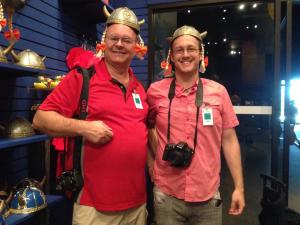
Did you get a chance to check out the Viking exhibition at the Royal BC Museum in the summer? I got a special in depth look at the locks and keys that were on display.
How much do you know about Vikings? Maybe you’ve watched “Vikings” on History Channel. Maybe you remember learning about Erik the Red in elementary school. The Vikings exhibition that came to the Royal BC Museum was an excellent opportunity to learn more about Vikings. Some of the most interesting artifacts included in the exhibition were the Viking-age locks and keys. Mr. Locksmith Victoria was the only Victoria locksmith to get special access to the Viking exhibition at the Royal BC Museum.
The Viking civilization was a technologically advanced society. Evidence of this technology is seen in their locks and keys. Locks and keys held special significance in Viking society, and are often found in Viking burials. Symbolically, keys were believed to grant access to the afterlife. Viking women were not allowed access to the afterlife, yet keys are especially common in women’s graves. Keys are believed to allow women to enter Valhalla. Material wealth was important in Viking society, and locks were needed to keep this wealth secure. As a result, keys became a symbol of wealth and status, and were often elaborately constructed and worn as jewelry.
Viking Keys
There are three main types of keys found at Viking archaeology sites, stem keys, hook keys, and leaf-spring keys. Stem keys operated mounted tumbler and bolt locks. Stem keys became more prominent after the 8th century. The keys are made from a single strip of metal, and has a hollow stem which fits over a spindle in the back of the lock. Hook keys have an L-shaped hook and are often found attached to decorative chains and jewelry. Typically made from iron or bronze, these keys operated mounted locks. The earliest example of L-shaped key technology comes from Greece. Leaf-spring keys opened Viking padlocks. Padlocks used leaf-springs, attached to the bolt to keep the lock shut. These C-shaped keys were inserted into the lock to compress the leaf-springs, releasing the tension and opening the lock.
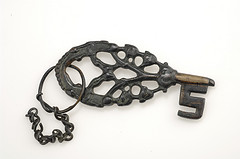
This finely crafted Stem Key indicates the value that keys held as a form of jewelry and the complex craftsmanship that went into making keys
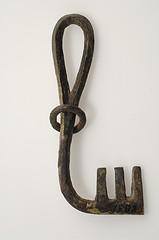
The Viking Hook Key resembles latch keys found on Egyptian, Greek and Roman door locks. Typically, the cuts fit into a bar of wood which allow the bolt to be manually lifted to unlock the door.
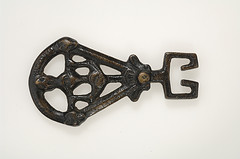
Leaf-Spring Keys were used to open Viking-age padlocks. The lock used a spring system to keep the bolt locked. The key was inserted into the lock and depressed the spring between the two metal prongs.
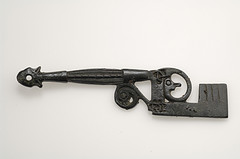
This is a good example of a Viking age ‘symbolic’ key. Note that the key is highly decorated, and only has superficial biting or cuts. Symbolic keys are often found in women’s graves along with jewelry and other keys.
Viking Locks
There are several types of locks that are believed to have been used by Viking peoples, including padlocks, lock boxes, and mounted locks. Viking padlocks can be divided into two types; barrel padlocks and box padlocks; however, the operating principles between them are the same. Older padlocks had the keyhole opposite of the padlock bolt. Padlocks of this form are found in pre-Viking pagan graves in contexts dated up to and beyond the Norman Conquest. In the 8th or 9th century, new padlock innovations led to a T-shaped keyhole on the face of the lock. This design is believed to have originated in China
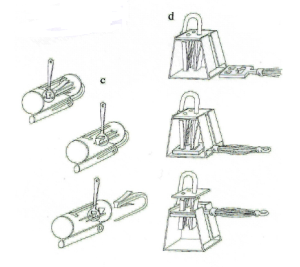
Leaf springs attached to the core of the lock apply pressure against the lock housing, which keeps the lock shut. The padlock key is inserted into the lock and depresses the leaf springs, releasing the tension and opening the lock.
Viking age mounted locks existed in two forms. Lock boxes are seen exclusively on chests and caskets. It had a sliding bolt which, when closed, was held in place by springs. The springs were released by a key with an L-shaped or T-shaped bit, the latter requiring a slot in the centre of the bolt. Once the springs were released, the bolt could be moved back to release the hasp. A bolt found at Lakenheath (Suffolk) indicates that this type of lock may be Roman in origin. Otherwise the first appearance of this technology is on caskets in pagan graves of the 6th – 7th centuries. Numerous examples have also been found on the Middle Anglo-Saxon burial chests from Ripon and Thwing.
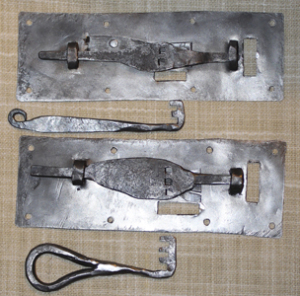
Little is known about Viking-age mounted locks. There is some evidence which indicates these locks were used on house doors.
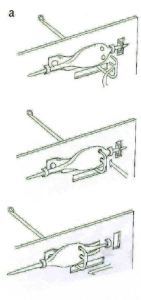
A hook key is inserted through a slit in the door. The bitting on the keys hooks into grooves in the bolt. The bolt can then be manually slid open.
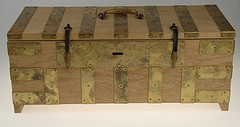
Lock boxes were a common way for Viking peoples to secure their belongings. Lock boxes were a common target during Viking raids. The lock boxes were often highly decorated and contained great amounts of coin, jewelry, and sacred artifacts. It is possible that the Vikings were able to reverse engineer mounted-lock technology from lock boxes stolen during the raids.
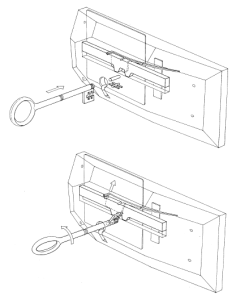
Some mounted locks and lock boxes needed to be opened using a stem key. The key was inserted into the keyhole and turned to lift the bolt and slide it open or closed.
The Viking locks and keys reveal a culture that was technologically advanced, with influences stretching across Europe and into Asia. Complex and highly decorative, the locks and keys show that the Viking peoples held a great deal of symbolic value to these objects. Keys were displayed as a symbol of wealth, and Viking women were buried with them as assurance of their admittance to the afterlife.
For more information regarding the Viking Exhibition, check out the Stockholm Swedish History Museum Flickr site. https://www.flickr.com/photos/historiska
For information about Mr. Locksmith, or locksmith-related inquiries, visit our webpage https://mrlocksmithvictoria.com/
Don’t forget to check us out on Facebook by clicking here, or on Twitter by following @VicMrLocksmith
To speak with a Victoria locksmith, contact Brian at 250 999 8990 or Brian@MrLocksmith.com
Written by Brian W.
4th generation locksmith
Bachelors in Anthropology and Professional Writing.
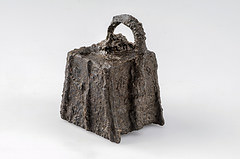










 Many locksmiths in the Vancouver / lower mainland area are looking to cut corners and reduce their accountability. Ask your locksmith if they are fully licenced, bonded and insured – like we are.
Many locksmiths in the Vancouver / lower mainland area are looking to cut corners and reduce their accountability. Ask your locksmith if they are fully licenced, bonded and insured – like we are.
Speak Your Mind